Discerning Xylella fastidiosa-Infected Olive Orchards in the Time Series of MODIS Terra Satellite Evapotranspiration Data by Using the Fisher–Shannon Analysis and the Multifractal Detrended Fluctuation Analysis
Abstract
:1. Introduction
2. Methods
2.1. The Periodogram Analysis and Spectral Filtering
2.2. The Fisher–Shannon Analysis
2.3. The Multifractal Detrended Fluctuation Analysis
2.4. The ROC Analysis
3. Data and Study Area
4. Results
5. Discussion and Conclusions
Author Contributions
Funding
Data Availability Statement
Conflicts of Interest
References
- Pyšek, P.; Hulme, P.; Simberloff, D.; Bacher, S.; Blackburn, T.; Carlton, J.; Dawson, W.; Essl, F.; Foxcroft, L.; Genovesi, P.; et al. Scientists’ warning on invasive alien species. Biol. Rev. 2020, 95, 1511–1534. [Google Scholar] [CrossRef] [PubMed]
- Wallingford, P.; Morelli, T.; Allen, J.; Beaury, E.; Blumenthal, D.; Bradley, B.; Dukes, J.; Early, R.; Fusco, E.; Goldberg, D.; et al. Adjusting the lens of invasion biology to focus on the impacts of climate-driven range shifts. Nat. Clim. Chang. 2020, 10, 398–405. [Google Scholar] [CrossRef]
- Chaloner, T.; Gurr, S.; Bebber, D. Plant pathogen infection risk tracks global crop yields under climate change. Nat. Clim. Chang. 2021, 11, 710–715. [Google Scholar] [CrossRef]
- Sorensen, J.; Gill, R. A range extension of Homalodisca coagulata (Say) (Hemiptera: Clypeorrhyncha: Cicadellidae) to southern California. Pan-Pac. Entomol. 1996, 72, 160–161. [Google Scholar]
- Janse, J.; Obradovic, A. Xylella fastidiosa: Its biology, diagnosis, control and risks. J. Plant Pathol. 2010, 92, S35–S48. [Google Scholar]
- Schneider, K.; van der Werf, W.; Cendoya, M.; Mourits, M.; Navas-Cortés, J.; Vicent, A.; Oude Lansink, A. Impact of Xylella fastidiosa subspecies pauca in European olives. Proc. Natl. Acad. Sci. USA 2020, 117, 9250–9259. [Google Scholar] [CrossRef] [PubMed] [Green Version]
- Hearon, S.; Sherald, J.; Kostka, S. Association of xylem-limited bacteria with elm, sycamore, and oak leaf scorch. Can. J. Bot. 1980, 58, 1986–1993. [Google Scholar] [CrossRef]
- Wells, J. Isolation, culture, and pathogenicity of the bacterium causing phony disease of peach. Phytopathology 1980, 73, 859. [Google Scholar] [CrossRef]
- Saponari, M.; Boscia, D.; Nigro, F.; Martelli, G. Identification of DNA sequences related to Xylella fastidiosa in oleander, almond and olive trees exhibiting leaf scorch symptoms in Apulia (Southern Italy). J. Plant Pathol. 2013, 95, 668. [Google Scholar]
- Jeger, M.; Caffier, D.; Candresse, T.; Chatzivassiliou, E.; Dehnen-Schmutz, K.; Gilioli, G.; Grégoire, J.C.; Jaques Miret, J.; MacLeod, A.; Navajas Navarro, M.; et al. Scientific opinion on the updated pest categorisation of Xylella fastidiosa. EFSA J. 2018, 16, 5357. [Google Scholar]
- Krugner, R.; Sisterson, M.S.; Chen, J.; Stenger, D.C.; Johnson, M.W. Evaluation of olive as a host of Xylella fastidiosa and associated sharpshooter vectors. Plant Dis. 2014, 99, 1186–1193. [Google Scholar] [CrossRef] [Green Version]
- Haelterman, R.M.; Tolocka, P.A.; Roca, M.E.; Guzmán, F.A.; Fernández, F.D.; Otero, M.L. First presumed diagnosis of Xylella fastidiosa causing olive scorch in Argentina. J. Plant Pathol. 2015, 97, 393. [Google Scholar]
- Coletta-Filho, H.D.; Francisco, C.S.; Lopes, J.R.S.; de Oliveira, A.F.; da Silva, L.F.O. First report of olive leaf scorch in Brazil, associated with Xylella fastidiosa subsp. pauca. Phytopathol. Mediterr. 2016, 55, 130–135. [Google Scholar]
- Giampetruzzi, A.; Chiumenti, M.; Saponari, M.; Donvito, G.; Italiano, A.; Loconsole, G.; Boscia, D.; Cariddi, C.; Martelli, G.P.; Saldarelli, P. Draf genome Sequence of Xylella fastidiosa CoDiRO Strain. Genome Announc. 2015, 3, e01538-14. [Google Scholar] [CrossRef] [PubMed] [Green Version]
- Strona, G.; Carstens, C.J.; Beck, P.S. Network analysis reveals why Xylella fastidiosa will persist in Europe. Sci. Rep. 2017, 7, 71. [Google Scholar] [CrossRef] [PubMed] [Green Version]
- Bock, C.; Poole, G.; Parker, P.; Gottwald, T. Plant disease severity estimated visually, by digital photography and image analysis, and by hyperspectral imaging. CRC Crit. Rev. Plant Sci. 2010, 29, 59–107. [Google Scholar] [CrossRef]
- Castrignanó, A.; Belmonte, A.; Antelmi, I.; Quarto, R.; Quarto, F.; Shaddad, S.; Sion, V.; Muolo, M.R.; Ranieri, N.A.; Gadaleta, G.; et al. Semi-Automatic Method for Early Detection of Xylella fastidiosa in Olive Trees Using UAV Multispectral Imagery and Geostatistical-Discriminant Analysis. Remote Sens. 2021, 13, 14. [Google Scholar] [CrossRef]
- Zarco-Tejada, P.; Camino, C.; Beck, P.; Calderon, R.; Hornero, A.; Hernández-Clemente, R.; Kattenborn, T.; Montes-Borrego, M.; Susca, L.; Morelli, M.; et al. Previsual symptoms of Xylella fastidiosa infection revealed in spectral planttrait alterations. Nat. Plant. 2018, 4, 432–439. [Google Scholar] [CrossRef] [Green Version]
- Camino, C.; Calderón, R.; Parnell, S.; Dierkes, H.; Chemin, Y.; Román-Écija, M.; Montes-Borrego, M.; Landa, B.B.; Navas-Cortes, J.A.; Zarco-Tejada, P.J.; et al. Detection of Xylella fastidiosa in almond orchards by synergic use of an epidemic spread model and remotely sensed plant traits. Remote. Sens. Environ. 2021, 260, 112420. [Google Scholar] [CrossRef]
- Frieden, B.R. Fisher information, disorder, and the equilibrium distributions of physics. Phys. Rev. A 1990, 41, 4265–4276. [Google Scholar] [CrossRef]
- Shannon, C.E. A mathematical theory of communication. Bell Syst. Tech. J. 1948, 27, 379–423. [Google Scholar]
- Kantelhardt, J.W.; Zschiegner, S.A.; Konscienly-Bunde, E.; Havlin, S.; Bunde, A.; Stanley, H.E. Multifractal detrended fluctuation analysis of nonstationary time series. Phys. A 2002, 316, 87–114. [Google Scholar]
- Martin, M.; Perez, J.; Plastino, A. Fisher information and nonlinear dynamics. Physica A 2001, 291, 523–532. [Google Scholar]
- Fawcett, T. An introduction to ROC analysis. Pattern Recognit. Lett. 2006, 27, 861–874. [Google Scholar] [CrossRef]
- Saponari, M.; Giampetruzzi, A.; Loconsole, G.; Boscia, D.; Saldarelli, P. Xylella fastidiosa in Olive in Apulia: Where We Stand. Phytopathology 2019, 109, 175–186. [Google Scholar] [CrossRef] [PubMed] [Green Version]
- Laipelt, L.; Kayser, R.H.B.; Fleischmann, A.S.; Ruhoff, A.; Bastiaanssen, W.; Erickson, T.A.; Melton, F. Long-term monitoring of evapotranspiration using the SEBAL algorithm and Google Earth Engine cloud computing ISPRS. J. Photogramm. Remote. Sens. 2021, 178, 81–96. [Google Scholar]
- European Union (EU). Commission Implementing Decision (EU) 2018/927 of 27 June 2018 Amending Implementing Decision (EU) 2015/789 as Regards Measures to Prevent the Introduction into and the Spread within the Union of Xylella fastidiosa (Wells et al.) Notified under Document C (2018) (683 3972). 2018. Available online: https://eur-lex.europa.eu/legal-content/EN/TXT/PDF/?uri=CELEX:32018D0927 (accessed on 25 May 2023).
- Chen, Z.; Ivanov, P.C.; Hu, K.; Stanley, H.E. Effect of nonstationarities on detrended fluctuation analysis. Phys. Rev. E 2002, 65, 041107. [Google Scholar] [CrossRef] [Green Version]
- Telesca, L.; Aromando, A.; Faridani, F.; Lovallo, M.; Cardettini, G.; Abate, N.; Papitto, G.; Lasaponara, R. Exploring Long-Term Anomalies in the Vegetation Cover of Peri-Urban Parks Using the Fisher-Shannon Method. Entropy 2022, 24, 1784. [Google Scholar] [CrossRef] [PubMed]
- Ciervo, M. The olive quick decline syndrome (OQDS) diffusion in Apulia Region: An apparent contradiction according to the agricultural model. Rev. Belg. Geogr. 2016, 4, 1–22. [Google Scholar] [CrossRef] [Green Version]
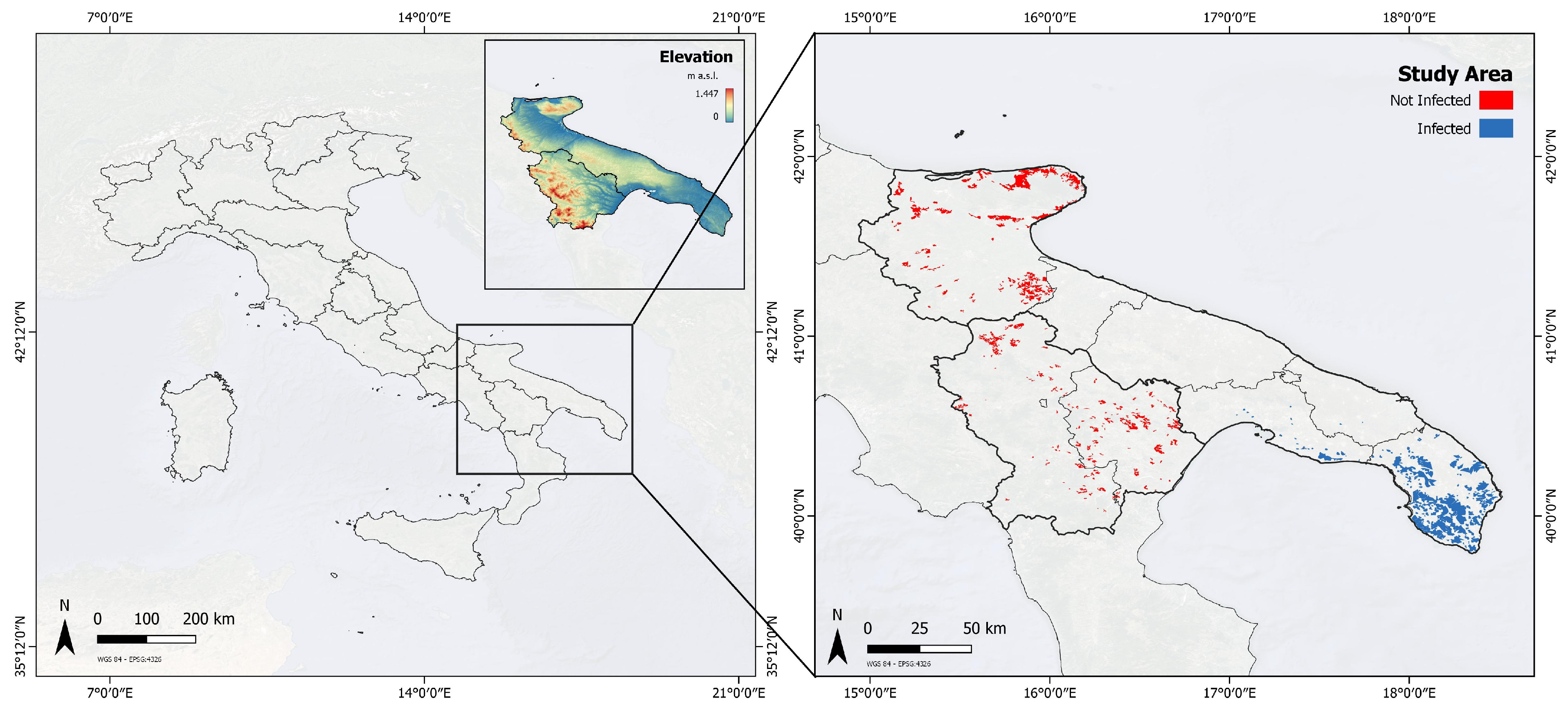



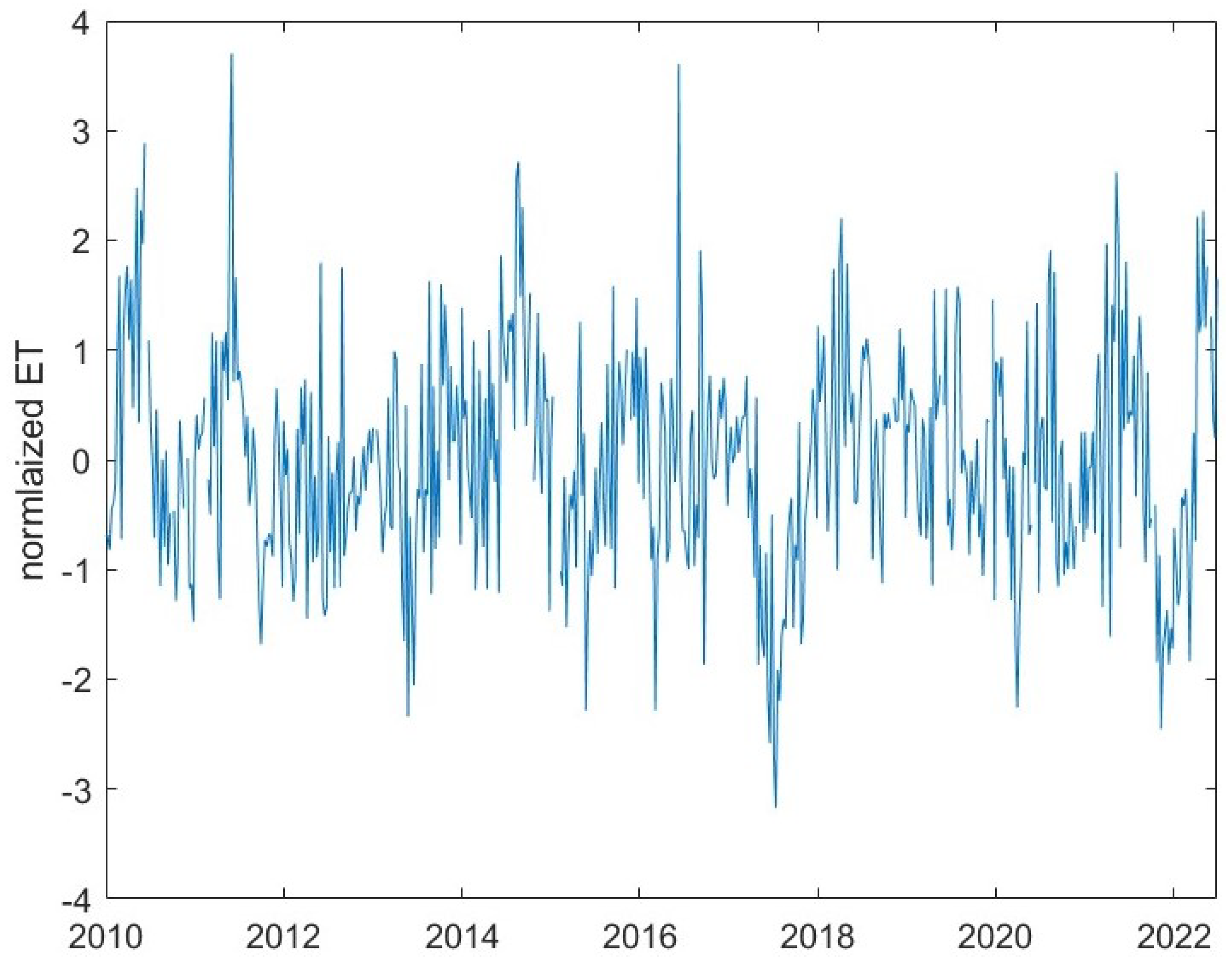
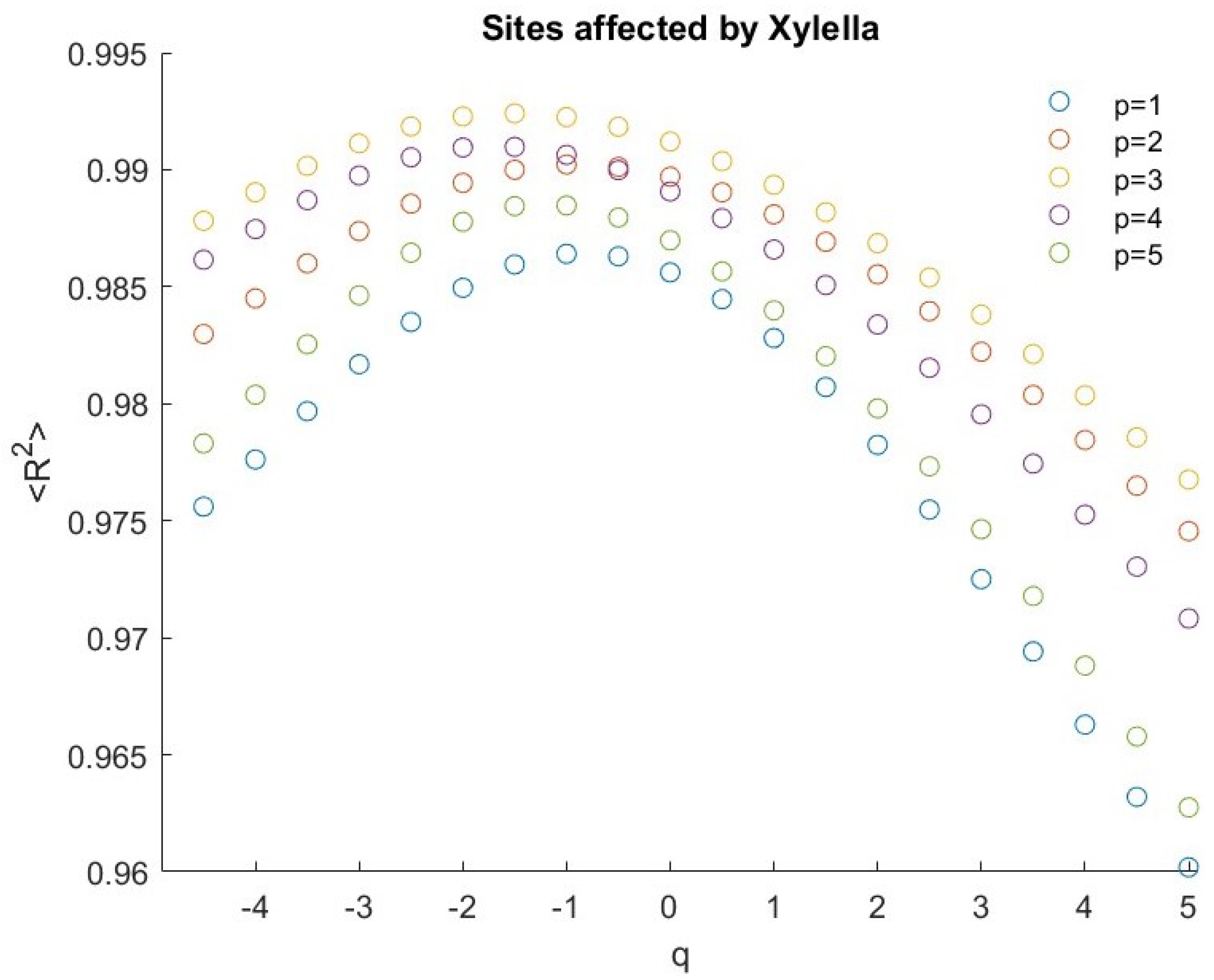

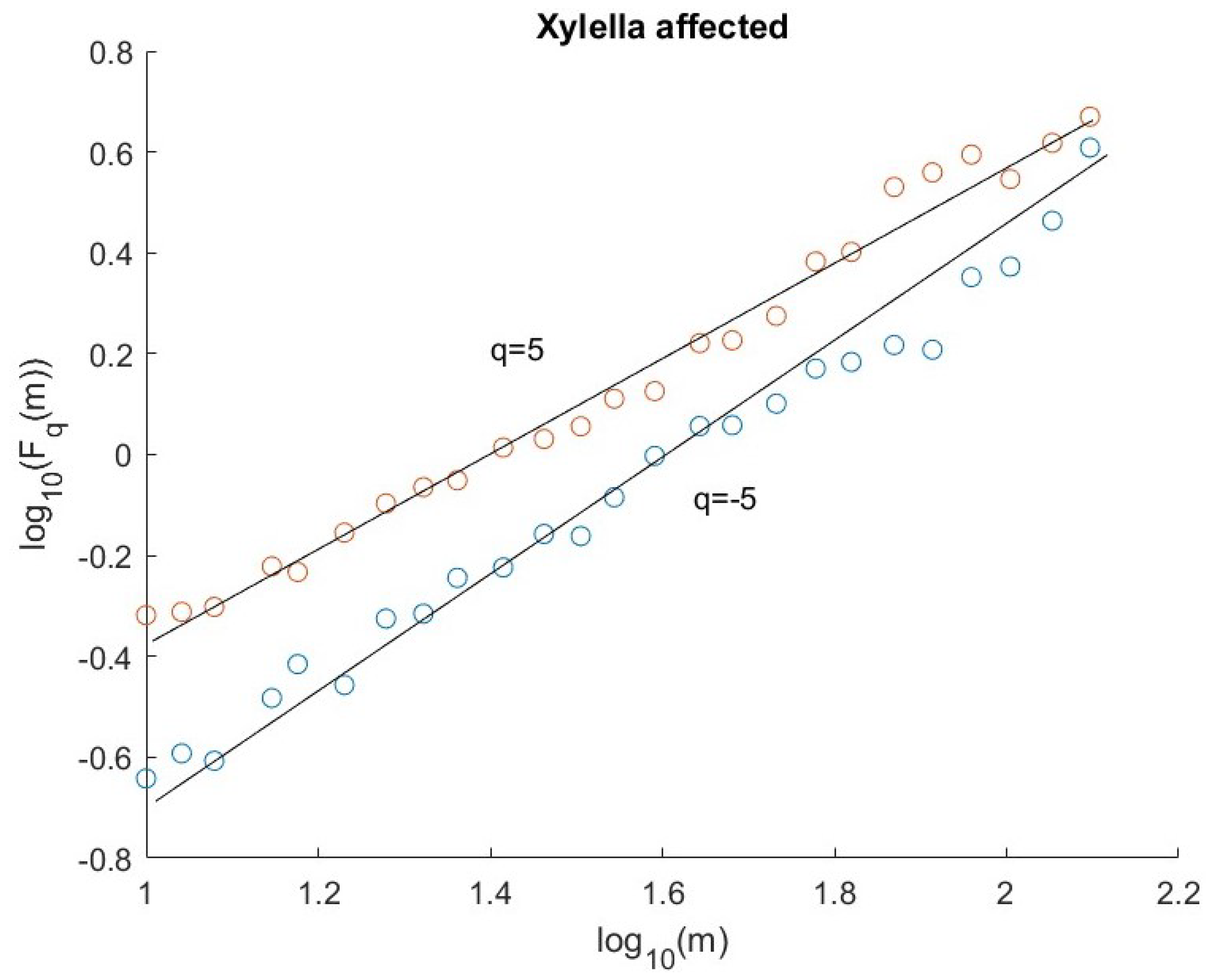
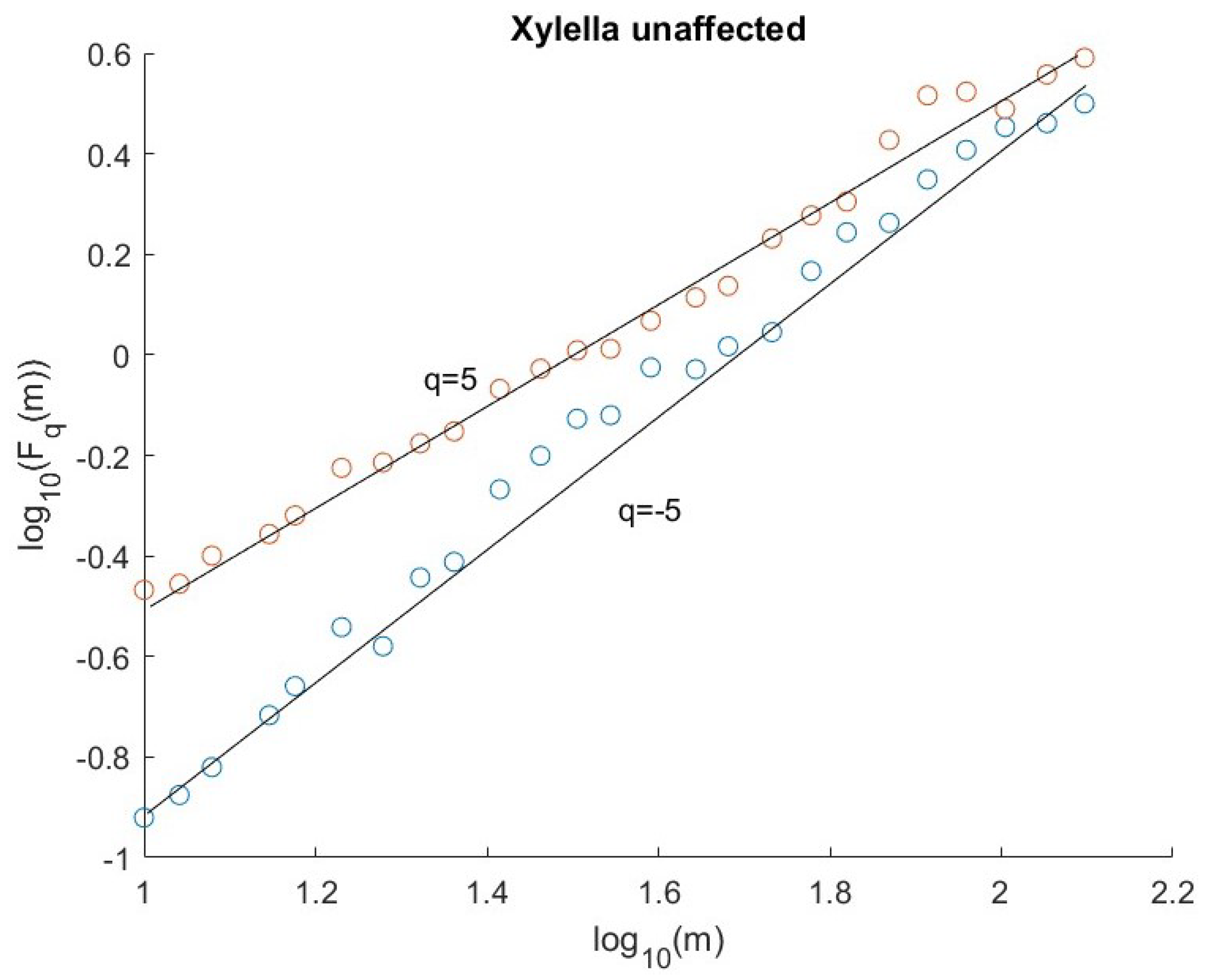
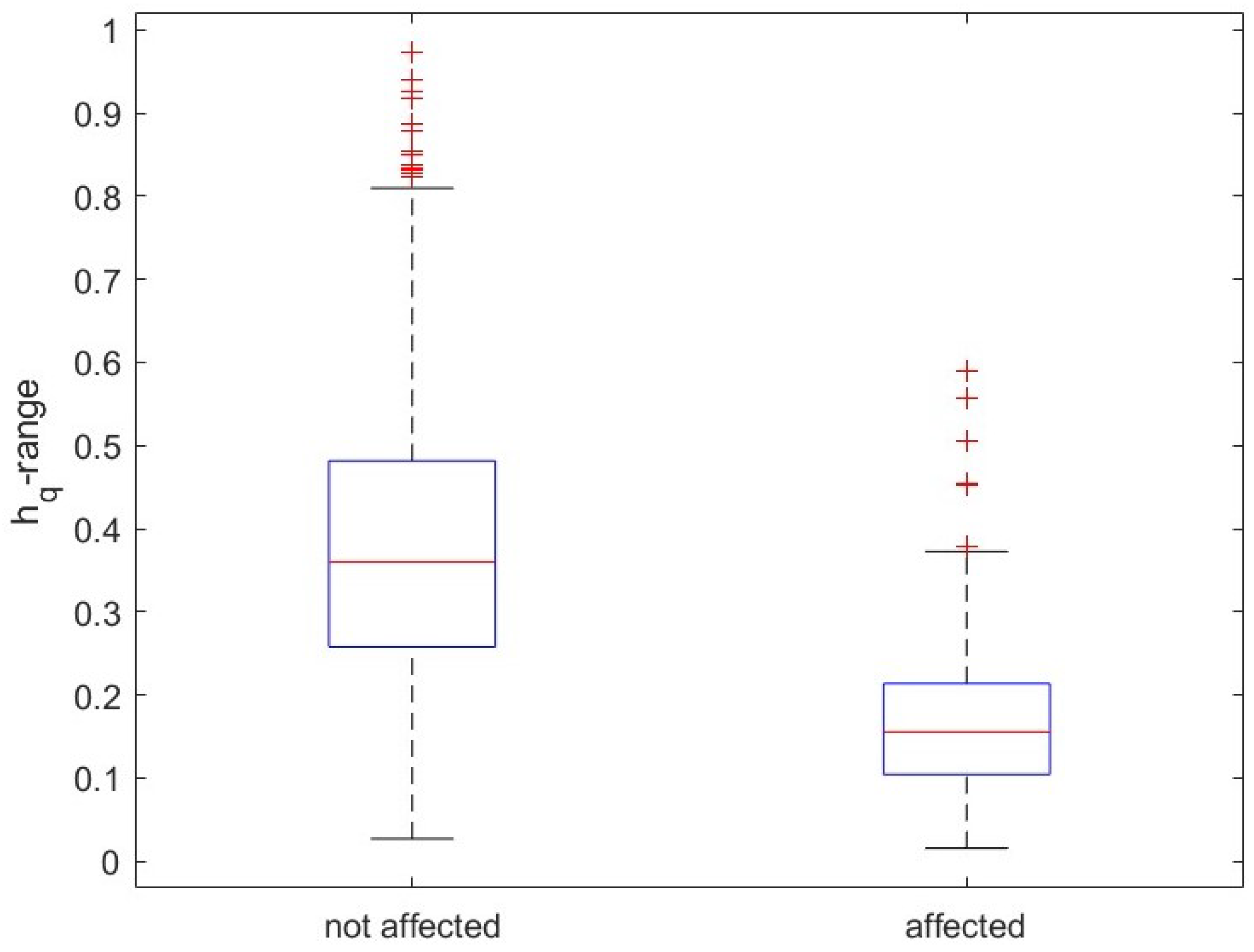
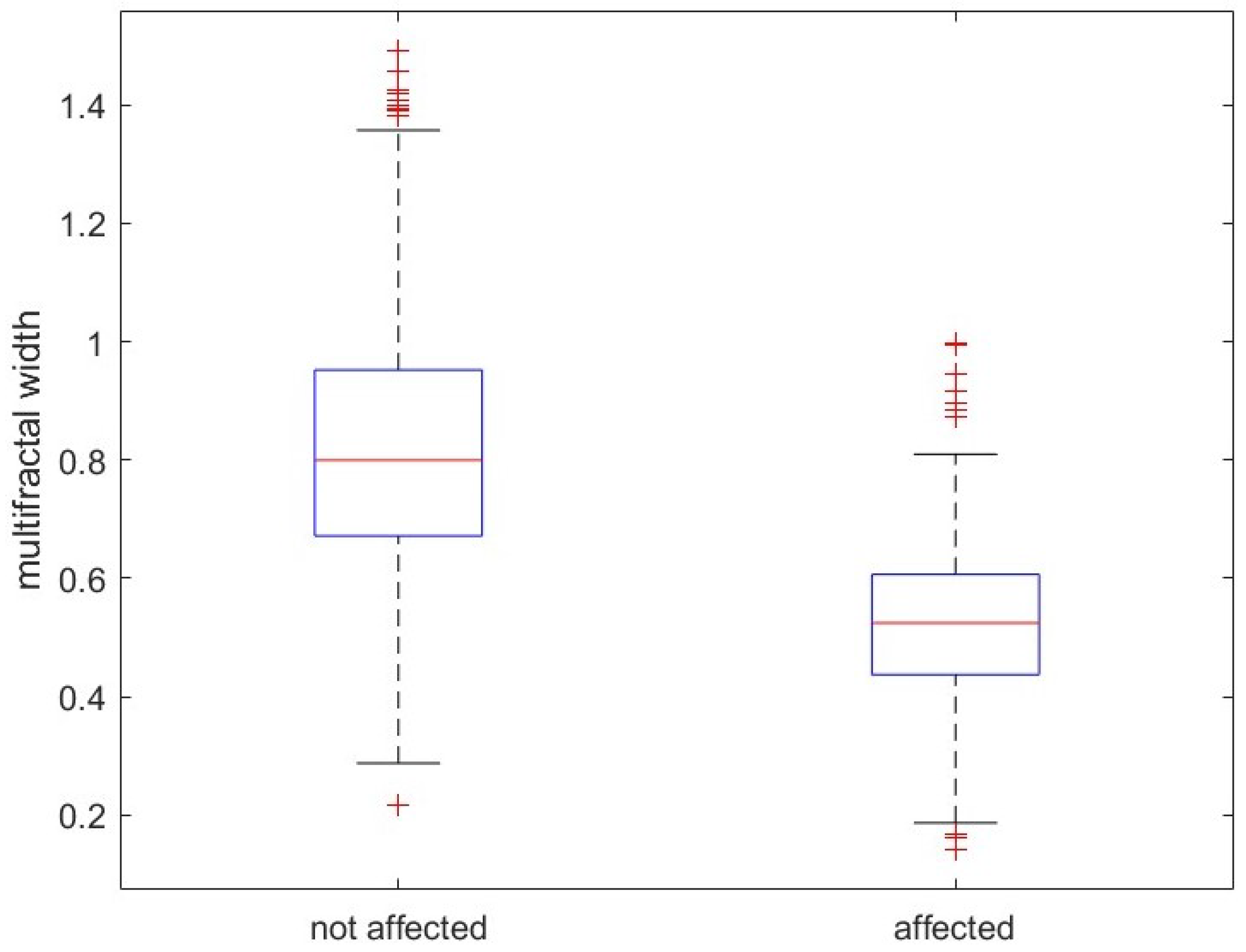

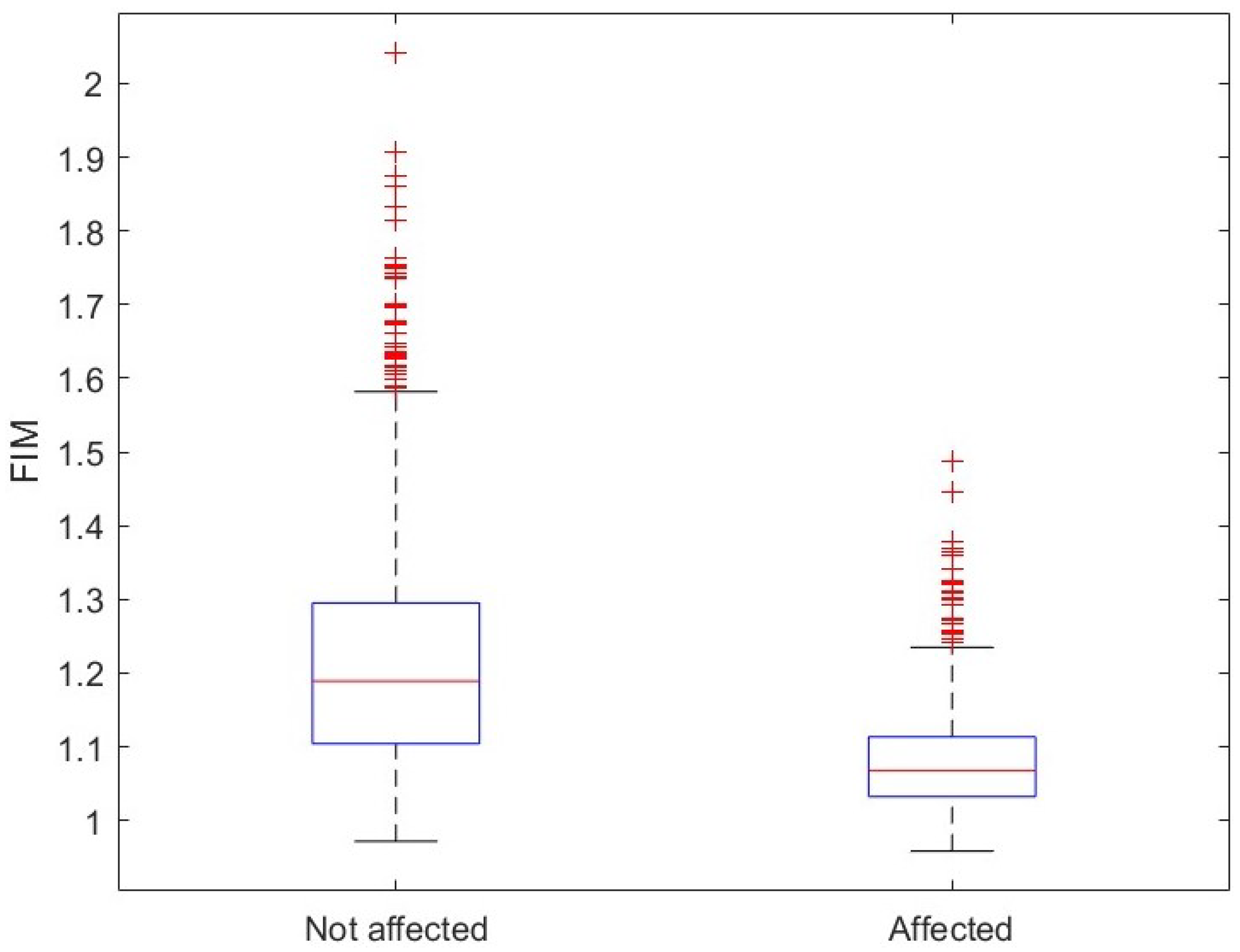


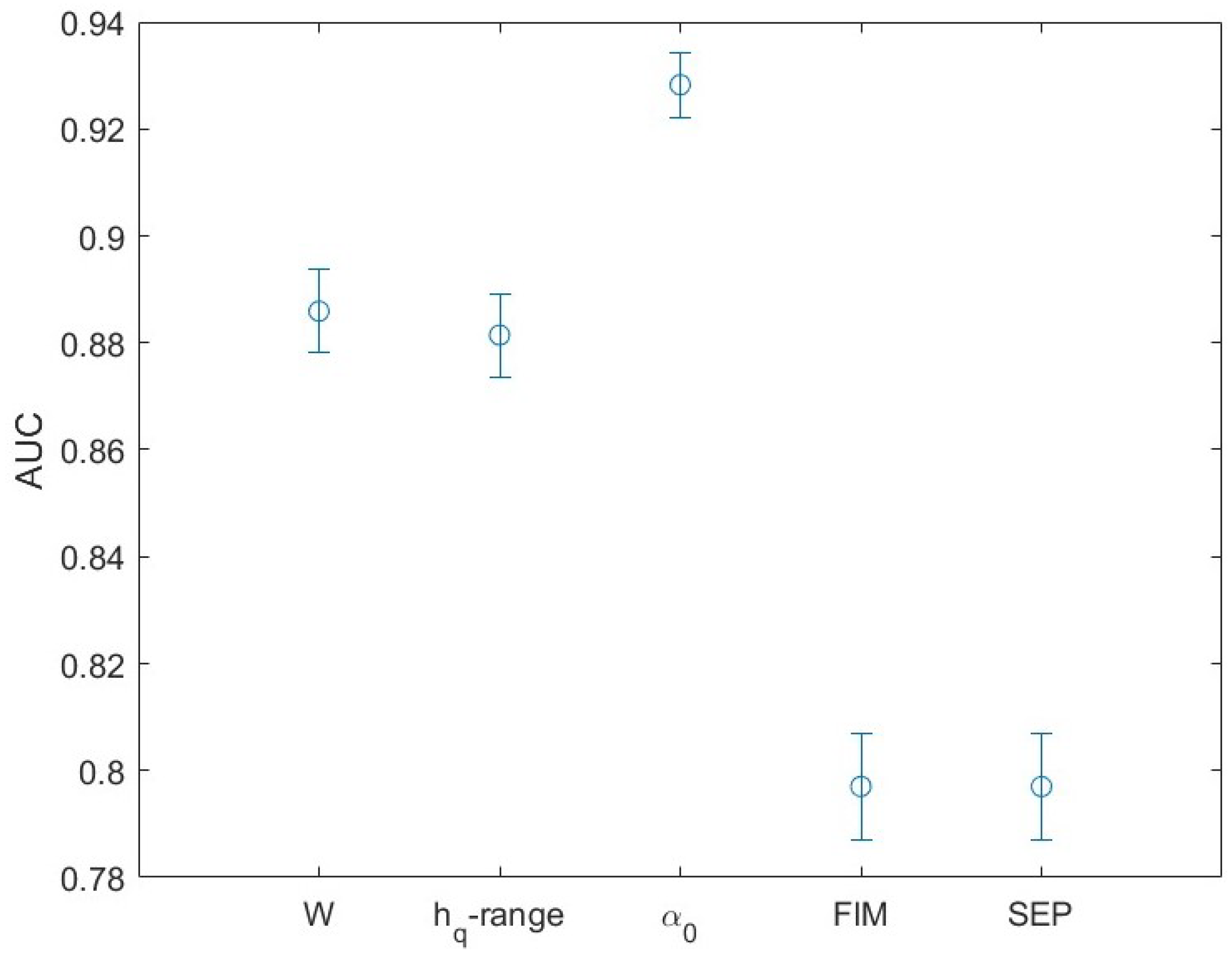
| Parameter | Average | Minimum | Maximum | |
|---|---|---|---|---|
| -range | 0.1634 (0.3784) | 0.0806 (0.1691) | 0.0156 (0.0272) | 0.58937 (0.9732) |
| W | 0.5222 (0.8168) | 0.1299 (0.2106) | 0.1410 (0.2157) | 0.9983 (1.4920) |
| 1.042 (/1.2172) | 0.0763 (0.0875) | 0.7798 (0.9686) | 1.3171 (1.4844) | |
| FIM | 1.080 (1.2204) | 0.0689 (0.1610) | 0.9582 (0.9716) | 1.4880 (2.0421) |
| SEP | 1.0282 (0.9845) | 0.0235 (0.0515) | 0.8166 (0.6278) | 1.0774 (1.0719) |
| Parameter | Threshold | TPr | FPr |
|---|---|---|---|
| -range | 0.2251 | 0.8342 | 0.2109 |
| W | 0.6358 | 0.8337 | 0.2022 |
| 1.1278 | 0.8564 | 0.1443 | |
| FIM | 1.1040 | 0.7634 | 0.2868 |
| SEP | 1.0183 | 0.7412 | 0.2493 |
Disclaimer/Publisher’s Note: The statements, opinions and data contained in all publications are solely those of the individual author(s) and contributor(s) and not of MDPI and/or the editor(s). MDPI and/or the editor(s) disclaim responsibility for any injury to people or property resulting from any ideas, methods, instructions or products referred to in the content. |
© 2023 by the authors. Licensee MDPI, Basel, Switzerland. This article is an open access article distributed under the terms and conditions of the Creative Commons Attribution (CC BY) license (https://creativecommons.org/licenses/by/4.0/).
Share and Cite
Telesca, L.; Abate, N.; Faridani, F.; Lovallo, M.; Lasaponara, R. Discerning Xylella fastidiosa-Infected Olive Orchards in the Time Series of MODIS Terra Satellite Evapotranspiration Data by Using the Fisher–Shannon Analysis and the Multifractal Detrended Fluctuation Analysis. Fractal Fract. 2023, 7, 466. https://doi.org/10.3390/fractalfract7060466
Telesca L, Abate N, Faridani F, Lovallo M, Lasaponara R. Discerning Xylella fastidiosa-Infected Olive Orchards in the Time Series of MODIS Terra Satellite Evapotranspiration Data by Using the Fisher–Shannon Analysis and the Multifractal Detrended Fluctuation Analysis. Fractal and Fractional. 2023; 7(6):466. https://doi.org/10.3390/fractalfract7060466
Chicago/Turabian StyleTelesca, Luciano, Nicodemo Abate, Farid Faridani, Michele Lovallo, and Rosa Lasaponara. 2023. "Discerning Xylella fastidiosa-Infected Olive Orchards in the Time Series of MODIS Terra Satellite Evapotranspiration Data by Using the Fisher–Shannon Analysis and the Multifractal Detrended Fluctuation Analysis" Fractal and Fractional 7, no. 6: 466. https://doi.org/10.3390/fractalfract7060466





